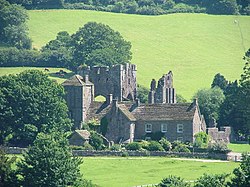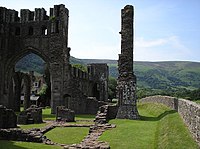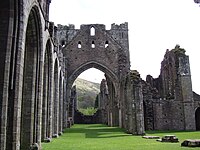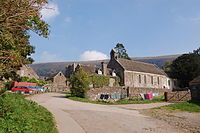Llanthony
| Llanthony Welsh: Llanddewi Nant Honddu | |
| Monmouthshire | |
|---|---|
 Llanthony Priory | |
| Location | |
| Grid reference: | SO287277 |
| Location: | 51°56’36"N, 3°2’15"W |
| Data | |
| Postcode: | NP7 |
| Local Government | |
| Council: | Monmouthshire |
| Parliamentary constituency: |
Monmouth |
Llanthony is a village in Monmouthshire. It stands in the midst of the Vale of Ewyas, a deep and long valley within the Black Mountains, seven miles north of Abergavenny and within the eastern section of the Brecon Beacons National Park. This is an isolated spot, the mountains rising steeply to either side, funnelling the River Honddu down between them. The highest points of both Monmouthshire (Chwarel y Fan) and Herefordshire (Black Mountain) are found close to the village at the peak of the mountains to west and east respectively.
The main focus of the village is found in the haunting ruins of Llanthony Priory.
The Offa's Dyke Path runs close by on the Hatterrall Ridge above the Vale of Ewyas and marks the boundary between Monmouthshire and Herefordshire. The area is popular for hillwalking, pony trekking horseback riders and mountain bikers.

Llanthony Priory
Llanthony Priory is a partly ruined former Augustinian priory secluded in the Vale of Ewyas at Llanthony. The main ruins are under the care of Cadw and entrance is free.
The priory is a Grade I listed building as of 1 September 1956.[1] Within the precincts of the Priory are two other buildings with Grade I listed status: the Abbey Hotel;[2] and the Church of St David.[3]
History

Foundation to dissolution
The priory dates back to around the year 1100, when according to tradition Walter de Lacy came upon a ruined chapel of St David here and was inspired to devote himself to solitary prayer and study. He was joined by Ersinius, a former Chaplain to Queen Matilda, the wife of King Henry I, and then a band of followers. A church was built on the site, dedicated to St John the Baptist, and consecrated in 1108. By 1118, a group of around 40 monks from England founded there a priory of Canons Regular; the first in Wales.
In 1135, after persistent attacks from the Welsh princes, the monks retreated to Gloucester where they founded a daughter cell, Llanthony Secunda. However, around 1186 another member of the de Lacy family, Hugh de Lacy, 1st Earl of Ulster, endowed the estate with funds from his estates in Ulster to rebuild the priory church, and this work was completed by 1217. The Priory became one of the great mediæval buildings, in a mixture of Norman and Gothic architectural styles. Renewed building took place around 1325, with a new gatehouse.
On Palm Sunday, 4 April 1327, the deposed King Edward II stayed at the Priory on his way from Kenilworth Castle to Berkeley Castle, where he is alleged to have been murdered.

Following Owain Glyndŵr's rebellion in the early 15th century, the Priory seems to have been barely functioning. In 1481 it was formally merged with its daughter cell in Gloucester, and after 1538 both houses were suppressed by Henry VIII's Dissolution of the Monasteries.
The 18th and 19th centuries
The buildings at Llanthony gradually decayed after the Dissolution to a ruin, although in the early eighteenth century the mediæval infirmary was converted to the Church of St David.[4] In 1799 the estate was bought by Colonel Sir Mark Wood, the owner of Piercefield House near Chepstow, who converted some of the buildings into a domestic house and shooting box. He then sold the estate in 1807 to the poet Walter Savage Landor. Landor intended to convert the estate into a model of a country gentleman's estate, planting trees, importing sheep from Spain, and improving the roads, though he never completed his plans. There is still an avenue of trees in the area known as "Landor's Larches" and many old chestnuts have been dated back to his time.[5]

Landor described the idylls of country life, including the nightingales and glow-worms in the valley to his friend Robert Southey. However the idyll was not to last long as for the next three years Landor was worried by the combined vexation of neighbours and tenants, lawyers and lord-lieutenant and even the Bishop of St David's. Many of his troubles stemmed from petty squabbles, arising from his headstrong and impetuous nature. He wasted money trying to improve the land, and the condition of the poorer inhabitants. The final straw was when he let his farmland to one Charles Betham whom Landor viewed as incompetent and extravagant and paid no rent. After an expensive action to recover the debts from Betham he had had enough, and decided to leave the country, abandoning Llanthony to his creditors - principally his mother. The estate was administered in his absence by his mother and cousin, but many of the buildings continued to disintegrate thereafter.

The priory was acquired by the Knight family in the 20th century. Wood's house later became the Abbey Hotel. The remaining ruins are protected by Cadw.
Llanthony in art
The ruins have attracted artists over the years, including JMW Turner who painted them from the opposite hillside.
Outside links
- The Brecon Beacons info on the Llanthony Valley
- Llanthony Priory in the Vale of Ewyas: the landscape impact of a mediæval Priory in the Welsh Marches
References
- ↑ Llanthony Priory – Monmouthshire - British Listed Buildings
- ↑ Abbey Hotel – Monmouthshire - British Listed Buildings
- ↑ Church of St David at Llanthony Priory – Monmouthshire - British Listed Buildings
- ↑ The Buildings of Wales: Monmouthshire, page 339
- ↑ John Sansom "Note for Brecon Beacons Park Society
- J. Newman (2000) The Buildings of Wales – Gwent / Monmouthshire (ISBN 0-14-071053-1)
Outside links
| ("Wikimedia Commons" has material about Llanthony) |
| ("Wikimedia Commons" has material about Llanthony Priory) |
